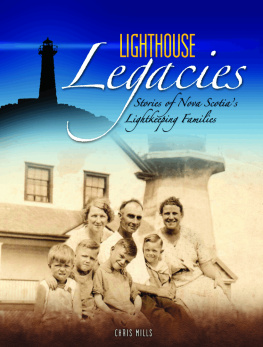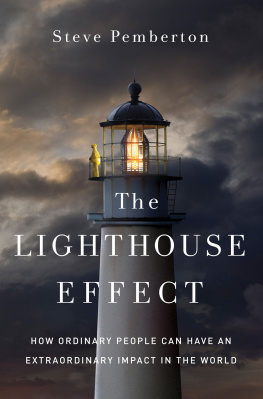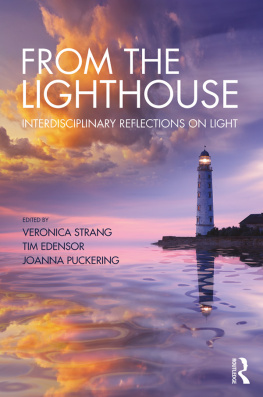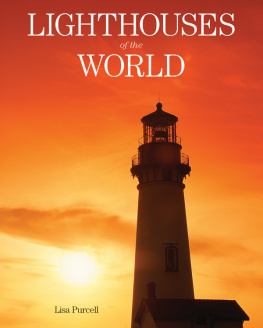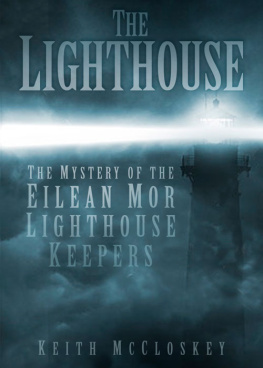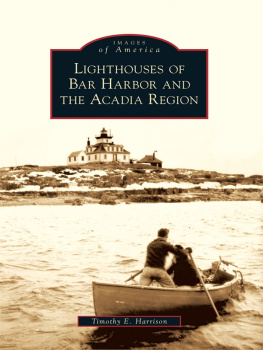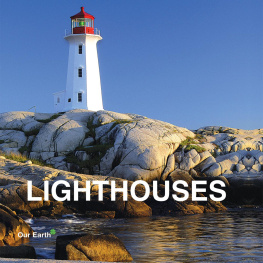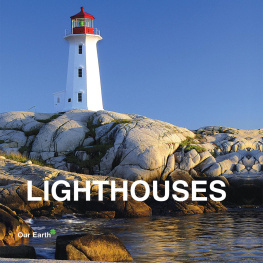Contents
Foreword
W arning! Visiting lighthouses can be incredibly fun for the entire familyand addictive. Along the way you will also have the opportunity to make many new friends and experience breathtaking seascapes that offer some of the most serene and beautiful locations on earth.
So go ahead, stare deep into the light that beckons the admirer to come nearer, but know that its alluring powers can be both profound and permanent on ones heart and mind. For I can think of no other man-made structure that is capable of evoking our deepest emotions or inspiring the most moving of artistic achievements than a lighthouse.
Their mere presence exudes a powerful sense of protection and purpose. Even if a person is unaware of lighthouses and the reasons they were built, their unique and often beautiful construction conveys an undeniable sense of great importance, for these benevolent beacons of the sea are no ordinary structures.
At the foot of a lighthouse swirl the ancient secrets of the sea. The vastness of the deep and its crashing surf serve as a constant reminder that the serenity of these grand locations can be replaced in a moments notice by the untamed power of the tempest, which historically wreaked havoc on many a ship, often causing tragic shipwrecks whose remains are strewn beneath the rocky ledges and shifting sands of our coastlines.
Before you can visit a lighthouse and experience its grand offerings of beauty and history, though, you have to first know how to get there, and lets face it: everyone needs a little help now and then when it comes to finding our way.
Global Position Satellite (GPS) in ones care is great, but Im of the belief that no technical instrument, regardless of capability, can ever fully replace that human voice when it comes to such topics as driving directions and intimate local knowledge.
If you are seeking out lighthouses, you do not just want to find them. Wouldnt it be nice to also be formally introduced to these guiding lights of the sea by someone in the know who has meticulously retraced the steps of the bygone lightkeepers before you?
No one is more qualified to serve as the companion voice on your personal lighthouse journey than Jeremy DEntremont, New Englands foremost lighthouse historian. Before you think that being introduced to a lighthouse is simply learning the driving directions, though, think again.
DEntremont has traveled countless lonely roads to lighthouses, sought out and traversed their obscure walking paths, and in many instances, scaled the staircases of these stately beacons to obtain more than just travel information, which makes The New England Lighthouse Handbook a must-have for both the novice and tried-and-true lighthouse enthusiast.
Within the pages of this volume, DEntremont demonstrates his prowess at being uniquely adept at presenting the entire realm of the lighthouse experience, from the important how-to-get-there information to the history and lore of each beacon, as well as fascinating tidbits of human interest that spark our imaginations and conjure up the golden age of lighthouses and their keepers.
Oh yes, there is something else you should know as you turn each page of The New England Lighthouse Handbook the mere act of doing so can serve as the start of a new and exciting chapter in your own life. For on occasion, a visit to a lighthouse has been known to change the course of an individuals life, which is yet another fascinating possibility to ponder as you seek a temporary reprieve from the fast pace of society or perhaps the stress of your occupation.
With Jeremy DEntremonts New England Lighthouse Handbook as your guide, plan your next trip to a lighthouse today, for time and the tides wait for no one. Along your journey from light to light, be prepared to experience unbridled fun and satisfaction, and remember to absorb every ounce of romance, mystery, strength, inspiration, and spiritual renewal that you can possibly derive from seeking out New Englands beckoning beacons!
Bob Trapani, Jr.
Executive Director
American Lighthouse Foundation
Introduction
I m often asked, What is it about lighthouses? Why do they mean so much to so many people? I usually hem and haw before I attempt a reply because there is no simple, succinct answer to the question. Certainly, lighthouses are often pretty or ruggedly handsome, and theyre usually in beautiful or dramatic locations. Some of them are marvels of engineering, the measure of the technology of their time. Theyre frequently among the oldest buildings in our coastal communities, and they serve as a link to centuries past. They remind us that our nation was built on maritime trade and that safe navigation was essential to the growth of that commerce. Beyond that, they speak to something deep inside us.
Lighthouses, perched defiantly on the turbulent line between land and sea, are symbols of steadfastness, hope, and strength. Theres primal power in the image of a light in the darkness, guiding sailors safely home. Its no accident that churches, schools, and all types of businesses have utilized the positive symbolism of the lighthouse as a guiding light.
For me, its the human history that grabs my attention above everything else. For centuries, keepers and families dedicated themselves, usually in obscurity and for little financial reward, to keeping the light lit at all costs. Connie Small, author of the classic book, The Lighthouse Keepers Wife, once said that she and her husband, Elson Small, didnt see lighthouse keeping as a job; they saw it as a calling.
Time and again, keepers and their families saw past their own perils and discomforts. They did what had to be done to serve the good of all. They also lived their lives in rugged and extreme conditions that most of us would consider unbearable. For better or worse, with automation its a way of life thats been relegated to the past in most of the world. With the passing of the age of the traditional keeper, a new form of keeper has evolved: the historic preservationist.
Theres endless human drama (humor, also) to be found in the study of lighthouses. If you dig deep enough into the history of almost any lighthouse, youre likely to find stories of great heroism and heartbreaking tragedies. Theres a good chance youll find a ghost story or two and maybe something offbeat like a bell-ringing fog dog. I hope this book will make you hungry for more of these stories.
The presentation of the lighthouses in this book is roughly south to north and west to east. In addition to driving directions for mainland lighthouses, information is provided on cruises, flights, and tours that enable the aficionado to view lighthouses that are unreachable by car.
Information on cruises and tours is obviously subject to change over time. This new edition is up to date at the time of its publishing, but you should always check ahead with local chambers of commerce, tourism bureaus, and lighthouse organizations to learn about current cruise and tour offerings.
A brief glossary is included at the back of the book, defining some of the terms that appear in the text. Ive tried to stay away from too much technical information in favor of human interest.
I hope this book will serve you well, and I hope it will make you want to learn more about these fascinating sites. I invite you to visit me online at www.lighthouse.cc New England Lighthouses: A Virtual Guide.
Happy lighthousing!
Jeremy DEntremont
Portsmouth, New Hampshire
June 2011
KEY TO ICONS
For each lighthouse in the book, icons are used to help convey information on accessibility, as follows:




